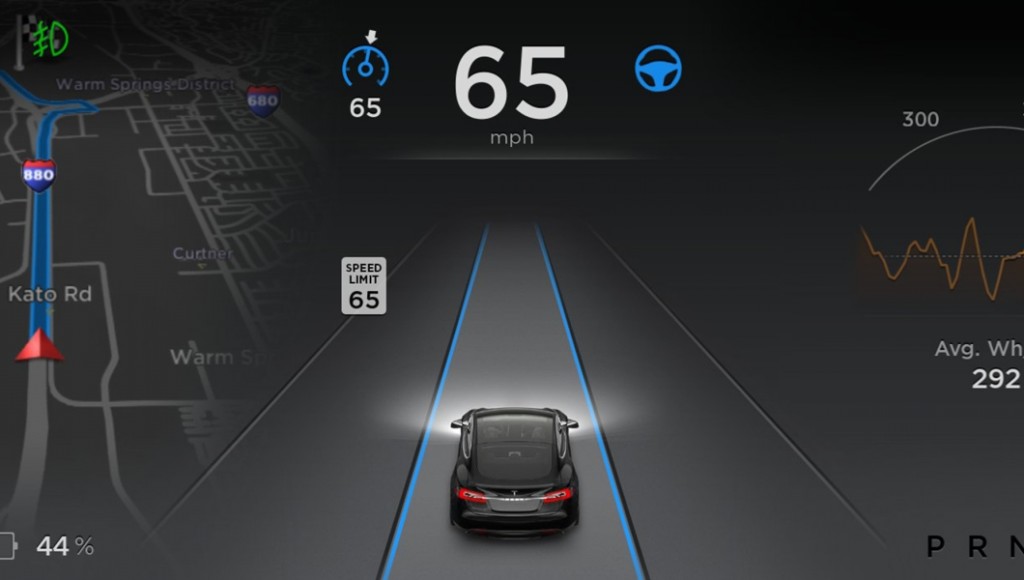
Robohub.org
Tesla sends highway cruise update to recent Model S owners

Source: Tesla
Though it’s been anticipated for a few months now, Tesla announced yesterday the release of their highway cruise update for Model S cars from the last year.
Tesla’s offering is not too different from the “highway cruise” other automakers have shown — essentially, a combination of lanekeeping and adaptive cruise control (ACC), both of which have been around for a while. The vehicle reportedly insists you keep your hands touching the wheel, but some owners report you can take them off. Of particular note is the addition of lane-changing, which you can do by flicking the turn signal. You must check behind you, since if you attempt this when the next lane is moving fast and somebody is coming up on you quickly, not knowing this fact could cause a real problem. The vehicle won’t do the lane change if its blind spot detector sees an adjacent car, but it won’t stop you from cutting off somebody who is not in that zone and gaining on you.
I am curious about the claim that the system will “overtake” another car — I have not tried it out yet, but I presume since it should not change lanes on its own, user input will be required to command driving around another car. While you can’t safely make a lane change into a lane where you see no cars, you actually can make the change after passing a car because you know where that car is and that nothing is going to rush at you in the lane.
The release of this and similar products will test a supposition I made earlier, that these products may not be as exciting as hoped. Worse, some drivers may find it a bit frightening to trust giving control to a vehicle knowing that from time to time they will need to grab the wheel. I myself have felt that apprehension when driving cars with adaptive cruise control. For example, since I’m able to see things like a stopped car ahead before the radar or camera system does, I have wondered if the automatic cruise control (ACC) will stop for it.
On the other hand, many people have reported that even though they must supervise, highway cruise can make the trip more relaxing, just as basic cruise control does. The trick is to get your brain into putting focus on its new sole task — to supervise — so that the rest of your brain can relax. With cruise control, you are reasonably able to have one part of your brain worry about steering, and relax the part that was going to worry about speed. So this may happen here.
More of a concern are the people who will trust it too much. Many of us already do crazy things, like texting or playing with things on our phones when we are doing fully manual driving, so it’s a given this will continue to happen in cars with highway cruise. But while it will be safer to take your eyes from the road for a longer period than you should with a manual car, people may magnify that. If you take your eyes off the road and the car ahead of you stops suddenly, the car will very probably brake for you — as will any car with forward collision avoidance — but not 100% of the time.
I may have more to say after taking a ride in one of these. I think the first really interesting product won’t be this, but a more full-auto traffic jam assist, that will drive for you in a traffic jam and allow you to take your attention off the road entirely to read or work on your phone or computer.
At the low speeds of a traffic jam, boxed in by other cars, the driving problem is much simpler. You don’t need to see the lanes, you just need to follow the cars. If the car in front of you zooms ahead, the traffic jam is over, and the driver needs to manually speed the car up. Done at low speeds, that transition can be fairly safe, and in addition, if the driver does nothing and the car slows to a halt, that is not unsafe — just annoying — in a breaking up traffic jam.
The main remaining problem in traffic jams is what to do when the cars in front of you change lanes. Are they turning just to go into another lane, or is it because all the lanes are turning due to restriping (common in jams) or an obstacle. You need to get that right, and let the driver know about it, but you can’t buzz the driver every time somebody does a lane change or the product is not useful.
Several car vendors (and probably Tesla) have been working on this, and could release it quite soon if they get the guts and legal approval to do so.
This post originally appeared on robocars.com.
tags: Automotive, autonomous driving, robocars, Tesla




